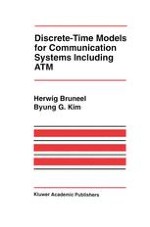1993 | OriginalPaper | Chapter
More Complicated Models
Authors : Herwig Bruneel, Byung G. Kim
Published in: Discrete-Time Models for Communication Systems Including ATM
Publisher: Springer US
Included in: Professional Book Archive
Activate our intelligent search to find suitable subject content or patents.
Select sections of text to find matching patents with Artificial Intelligence. powered by
Select sections of text to find additional relevant content using AI-assisted search. powered by
In the previous chapters, rather simple models have been adopted with respect to stochastic processes for inputs to and outputs from the buffer. Specifically, arrivals have been assumed to occur independently from one time slot to another, and the output channel, i.e., the server of the buffer queueing system, has been considered permanently available. Both these simplifying assumptions are not always realistic in real-life situations. For instance, in many applications the arrival process of units into the buffer is in some sense “correlated,” because users (or “data sources”) usually generate data in a “bursty” fashion, i.e., a user which is active in a given slot is very likely to generally remain inactive for a large number of consecutive slots. On the other hand, the output channel of a buffer system may be subject to (more or less) random interruptions, for various reasons: there may be failures of the channel, transmissions may be sometimes unreliable, the channel may have to be shared with other (higher priority) communication systems, etc. In order to be able to deal with these kinds of situations, more complicated queueing models than in the previous chapters are needed.
